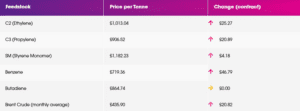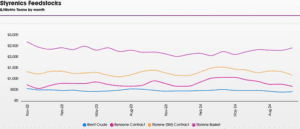
Plastribution’s Polymer Price Know-How: November 2024
|
Getting your Trinity Audio player ready...
|
Plastribution’s November Polymer Price Know-How highlights a steadying market amidst geopolitical and economic developments in the USA and the Middle East. While rising crude oil and Naphtha prices have led to slight increases in monomer costs, polyolefin prices largely resisted upward movement due to weak demand and ample supply. The strengthening USD, following Donald Trump’s election victory, introduces additional cost pressures for imported polymers. With seasonal demand remaining subdued and potential new tariffs on the horizon, the market faces an uncertain close to 2024, setting the stage for a dynamic start to 2025.
Before the US election result, European contract feedstock costs either settled with a rollover or increased. The main driver for this price inflation was not demand, but the increase in crude oil and Naphtha pricing.
Crude Oil prices spiked in October as a result of geopolitical tensions in the Middle East and in particular the reprisals from Israel on Iran, following the previous missile attack on Israel by Iran. Fears that Israel might attack oil and gas, and or, Iranian nuclear infrastructure were not realised, and crude oil prices have since moderated to some extent.
The leadup to the US election suggested that the outcome would be close, but Donald Trump won a decisive victory for the Republican Party and as a result, the USD has strengthened. This will result in upward price pressure for both polymers sourced from the Far East and for PE directly imported from the US. The change from a USD: GBP 1.34 down to 1.29 equates to about £85 per tonne for PE. It remains to be seen if Republican Party policies bring further strength to the US economy.
With the lull in seasonal demand that affects the UK and Western Europe, the possibility of price increases taking effect before the new year would appear to be remote. The evolution of crude oil prices and exchange rates is likely to set an interesting backdrop for polymer supply in January and beyond.
Monomer Price Movements
Exchange Rates
€- 1.20
$- 1.30
€/$- 1.19
Polyolefins
Polyolefin prices are mostly rolling over in November. Whilst Ethylene C2 and Propylene C3 both increased by €30 / MT and €25 / MT respectively, the market has resisted attempts to pass these increases through due to good availability and poor demand.
The outlook for December and 2025 is for prices to be relatively flat to slightly down, but we continue to face some uncertainty. Whilst freight rates have dropped recently, they are on the way back up and with potential new tariffs on goods imported to the USA in January, we may see a rush of demand for containers before they start.
Styrenics
Contract EU Styrene increases slightly, EU polymer steady.
Styrene Monomer has increased by just €5T, settling at €1415/T.
For November, EU GPPS, HIPS and ABS either rolled prices or followed the small increase.
GPPS/HIPS/ABS supply chains are still running very low. Polymer producers have been running output at a minimum due to poor demand, and converters and distributors running inventory at very low levels due to financial pressures. Therefore, any adjustments in polymer prices are likely to be passed on immediately.
Engineering Polymers
Demand remains weak so November will continue in the same theme as October. That means further cutbacks in production and downward pressure on prices for most engineering materials.
The November benzene contract settled €56/Mt higher than October at €861/Mt.
Sustainable Polymers
Recycled Polyolefins have mostly rolled over in November alongside prime prices.
There are some developments within the industry with a major recycling plant in the UK closing. We’ve also seen interesting developments with the recent Budget.
Packaging Tax is increasing in line with inflation and there will be changes to the rules on recycled content. When the new rules come into force, post-industrial content will no longer be eligible for packaging tax relief but they will allow chemical recycling to count.
Recycled LDPE / LLDPE
Recycled LDPE / LLDPE has mostly rolled over in November. High-quality grades continue to see strong demand and restricted availability leading to prices keeping above virgin.
Recycled HDPE
Recycled HDPE is typically rollover with industrial grades continuing to be under pressure. Unclear as to how the Viridor closure will affect the availability and pricing of HDPE going forward.
Natural grades for consumer packaging continue to see significant premiums over virgin prices.
Recycled PP
Recycled PP is rolling over in November. Prices are under some pressure with availability still good and demand slightly weak, but more specialised grades with tighter specifications are holding up better.
As with other recycled grades, high-quality natural commands a strong premium over virgin.
Price Know-How: November 2024 Full Report
Visit the Price Know-How website to read the November 2024 update, which details each market segment and material group produced by Plastribution’s expert product managers.
Subscribe and keep in the know.
Price Know-How, a decade-long trusted resource in the industry, provides essential updates on polymer pricing and market dynamics. This report is crafted by Plastribution, a leading polymer distributor, in collaboration with Plastics Information Europe.
Price Know-How is tailored specifically for the UK polymer industry, unlike many other price reports. They do all the currency conversions, so you don’t need to!
Please click here to subscribe for free and receive monthly updates directly to your inbox.
Read more on Plastribution here.
+44 (0) 1530 560560
Website
Email












